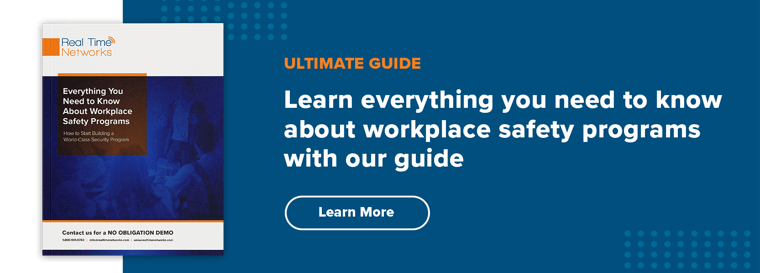
Good corporate security programs need to do more than just deal with threats after they appear. A good security program helps manage the legitimate flow of assets and people in your organization in order to identify potential threats before they cause any harm.
Visitor management systems are some of the most effective tools available for that task. They protect and monitor visitors and external workers to ensure their safety. They also give your security team the information they need to respond effectively when threats emerge.
What Is a Visitor Management System?
Visitor management is the process of monitoring people as they move into, through, and out of your facility. In a physical security context, “visitor” has a broad definition of anyone seeking to enter your facility for a limited period of time.
So “visitors” can be customers or staff family members. But they can also be service technicians, contract workers, and delivery people.
It is possible to conduct a basic level of visitor management with just a pen, paper, and human security officers. However, electronic security visitor management systems are available and provide many additional benefits.
Electronic Security Visitor Management Systems Provide Better Insight
Electronic systems have many features that manual, human-driven visitor management programs can’t replicate. These include:
- Real-time logging
- Real-time personnel tracking
- Instant notifications for security incidents
- Evacuation and mustering management
- Pairing a visitor badge with a staff badge so system can alert badges separate
The networking and data collection capabilities in electronic systems are what really set them apart. By monitoring visitor registrations and access requests over time, you develop a detailed history of how individual visitors and your organization as a whole behaves. Trends in this data reveal themselves over time, helping you identify security or staff performance issues that need to be addressed.
Networked electronic visitor management systems can also integrate with other networked security tools, such as access control or emergency mustering systems. When all of these technology platforms communicate directly with each other, you can more effectively respond to security incidents or full-blown emergencies.
Using an electronic system for visitor management also supports security convergence by unifying how your organization handles visitors that must enter both your physical and network security perimeters. As outsiders to your organization, visitors can slip through a gap in your controls if those two security domains don’t fully converge.
Who Benefits from Using a Security Visitor Management System?
While electronic visitor management systems can benefit any business, they are particularly valuable in certain business sectors. Organizations at high risk of experiencing unauthorized access attempts will see the most benefit. Industries under legal or regulatory burdens for controlling who can access their facilities will also benefit greatly.
Higher Education
Colleges and universities are often challenged by the flow of visitors on open campuses. They can deploy electronic visitor management to secure their most sensitive locations, such as student dorms or research buildings where they house regulated materials, like animal subjects and radiation sources.
Utilities and Energy Production
Companies in the energy sector make use of a number of specialized contractors and outside technicians to maintain power production equipment. That same equipment is also often protected by national security regulations. Electronic visitor management systems can make managing day-to-day operations in compliance with those federal regulations simpler.
Corrections
Electronic visitor management systems are often capable of integrating with access control and personnel management systems, such as guard tour solutions. Connecting these systems simplifies the complex process of monitoring which visitors, contractors, and staff are moving into and out of controlled spaces, such as cell blocks.
Gaming
Casinos and other gaming establishments want open and inviting customer-facing spaces. However, behind the scenes, they need to follow very specific access control laws dictating which staff and contractors are allowed in counting rooms and other secure spaces. Visitor management systems automate this process so security staff can turn their focus to gaming venues.
Industry and Manufacturing
Manufacturing and production floors are busy, dangerous places. Allowing visitors onto them can also inadvertently reveal trade secrets. Knowing who is moving where in your manufacturing facility can better protect both your visitors and business.
Construction
No matter whether they’re VIPs touring their new facility or experienced contractors entering a work zone, controlling and monitoring how visitors move around your construction sites will improve their safety.
8 Best Practices for Using Visitor Management Systems
Any business can benefit from a security visitor management system. But without proper planning, they may not get the most from their new technology. We have eight important best practices any organization deploying a new visitor management system should follow.
1. Align Visitor Management with Your Overall Security Goals
First, take a step back and figure out how visitor management will fit into your overall security plan. Are you mainly looking to reduce theft? Do you need to limit the risk of unattended personnel accessing hazardous locations? Do you need to better manage emergency response efforts?
Plan out how you will address these specific needs using existing policies, personnel, and security systems. Then consider what new visitor management resources you might need.
2. Collect Information at Visitor Intake
The specific security goals you’ve set will also help guide what information you need to collect at visitor intake. Consider whether you need to record:
- Visitor name
- Visitor contact information
- Emergency contact information
- Temperature or health information
- Expected visiting locations
- Date and time of visit
- Amount of time planned to visit
- Assigned chaperone staff member
3. Plan How to Get Visitors Out
The purpose of visitor management is not only to get visitors securely into your facility and through it but also safely out of it in the event of an emergency. Design an emergency mustering plan that includes provisions for evacuating all types of visitors in your facility, including:
- Contract employees who do not appear on official staff lists and directories
- Service technicians and delivery people
- External guests, such as customers, VIPs, and staff family members
4. Train Staff to Manage Visitors During an Emergency
Visitors aren’t going to be familiar with your evacuation plans. That responsibility falls on your security staff and emergency managers to protect them during a crisis.
Your organization should already be conducting evacuation drills. Include managing mock visitors as part of your drills and training. Have mock visitors stationed near hazard areas. Have emergency managers perform safety sweeps of those areas and escort visitors to muster points.
5. Integrate with Existing Security Systems
Visitor management systems are effective on their own but are even more useful when they’re integrated with the rest of your organization’s security systems. For example, integrating visitor management with your access control system allows you to authenticate visitors at critical checkpoints, allowing them to securely move through your facility unsupervised.
You can also consider integrating a visitor management system with your emergency mustering system. Then, in the event of an evacuation, your emergency managers will be able to track in real time which visitors are still on-site in the building, which are evacuating with staff, and which might be stranded or lost.
6. Centralize User Management
Centralized user management eliminates the redundant work of adding and modifying visitors in multiple security systems. This also reduces the chance of errors slowing down performance.
Central management also keeps all of your logs and reports in a single location. You can more easily generate comprehensive reports and monitor performance trends. Your IT department also only has to back up a single user database to protect information for every integrated system.
7. Analyze Visitor Management Data
Collecting data on visitor movement and access is essential for complying with many regulatory standards. Collecting large volumes of visitor data over time can also provide valuable insights into how your wider security program and business operate.
Data analysis might reveal problematic trends that staff were not aware of. For example, regularly denied access attempts in the same location might indicate staff has been incorrectly trained to use a certain entry point. Or it might indicate a potential insider threat attempting to access a secure location.
8. Review and Optimize Your Security Visitor Management Systems
The risks you face are always changing. Regularly evaluate your visitor management program for outdated practices or for new opportunities to protect your visitors and your business.
For example, do you need a new health screening process for visitors? Do you need more detailed reporting on access requests to a sensitive, new R&D facility?
Round Out Your Security Program with a Visitor Management System
Securing the flow of personnel, including staff and visitors, is more important now than ever before. Electronic visitor management systems can be the solution you need to protect your people and business assets cost-effectively in real time.
Check out our Emergency Mustering Roll Call Solutions page to see how you can better protect your visitors and staff during evacuations.

Subscribe to our blog

Jay Palter
Vice President of Marketing & Partnerships




